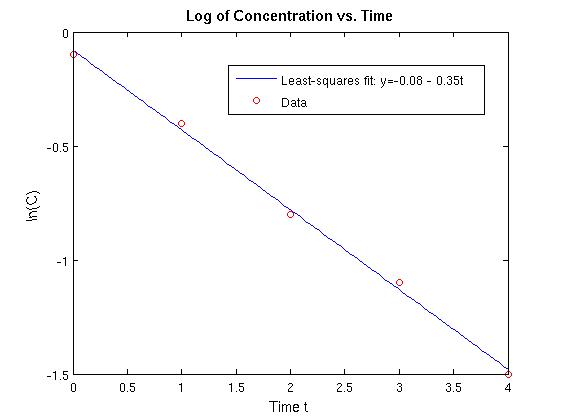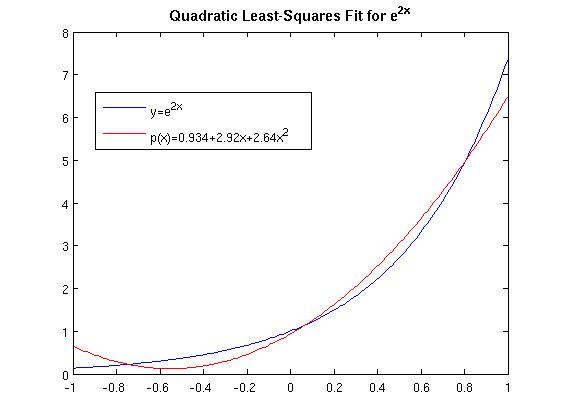| t | 0 | 1 | 2 | 3 | 4 |
|---|---|---|---|---|---|
| ln(C) | − 0.1 | − 0.4 | − 0.8 | − 1.1 | − 1.5 |
Solution. We want to find coefficients c1 and
c2 such that y = c + c2t is the best
straight line fit to the data. L1et u1 = [1 1 1 1
1]T,
u2 = [0 1 2 3 4]T, and
yd = [-0.1 -0.4 -0.8 -1.1 -1.5]T. Let S =
span{u1, u2}. Doing a
straight-line fit amounts to solving the least squares problem of
finding p such that
|| yd − p || = minu ∈ S
|| yd − u ||,
where the norm and inner product are the standard ones
for R5.
The Gram matrix G in this case has entries G11 =
u1Tu1 = 5, G12 =
u2Tu1 = 10,
G21 =G12 = 10, and G22 =
u2Tu2 = 30. Thus, G =
| 5 | 10 |
| 10 | 30 |

< f , g > = ∫ −11 f(x)g(x)dx and ||f|| = (∫ −11 f(x)2dx)½. The subspace S = P3 = span{1,x,x2}. Instead of using the basis {1,x,x2}, we will use the basis
p0(x) = 2-1/2, p1(x) = (3/2)1/2x, and p2(x)= (5/8)1/2(3x2-1).
These polynomials are called normalized Legendre polynomials and they are orthonormal: <pi, pj> = δij. In this basis, the quadratic polynomial that is the best least squares fit to e2x has the formp(x) = c1p0(x) + c2p(x) + c3p2(x).
Recall that when we use an orthonormal basis, the Gram matrix turns out to be the identity: G = I. The equation Gc = d thus becomes c = d. Doing the appropriate inner products we see that
c1 = d1 = < f, p0> = ∫
−11 e2xp0(x)dx =
8-1/2(e2 - e-2)
c2 = d2 = < f, p1> = ∫
−11 e2xp1(x)dx =
(3/32)1/2(e2 + 3e-2)
c3 = d3 < f, p2> = ∫
−11 e2xp2(x)dx =
(5/128)1/2(e2 - 13e-2)
The quadratic polynomial that is the best least squares fit to
e2x is
p(x) = (1/4)(e2 - e-2) + (3/8)(e2 +
3e-2)x + (5/32)(e2 -
13e-2)(3x2-1).
Both the function and quadratic least squares fit are plotted below.
